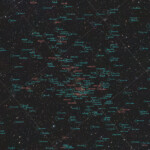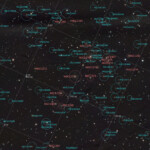The Perseus cluster (Abell 426) is a cluster of galaxies in the constellation Perseus. It has a recession speed of 5,366 km/s and a diameter of 863. It is one of the most massive objects in the known universe, containing thousands of galaxies immersed in a vast cloud of multimillion-degree gas.
NGC 1275 (also known as Perseus A or Caldwell 24) is a type 1.5 Seyfert galaxy located around 237 million light-years away in the direction of the constellation Perseus. NGC 1275 corresponds to the radio galaxy Perseus A and is situated near the center of the large Perseus Cluster of galaxies.
NGC 1275 consists of two galaxies, a central type-cD galaxy in the Perseus Cluster, and a so-called “high velocity system” (HVS) which lies in front of it. The HVS is moving at 3000 km/s towards the dominant system, and is believed to be merging with the Perseus Cluster. The HVS is not affecting the cD galaxy as it lies at least 200 thousand light years from it. However tidal interactions are disrupting it and ram-pressure stripping produced by its interaction with the intracluster medium of Perseus is stripping its gas as well as producing large amounts of star formation within it.
The central cluster galaxy contains a massive network of spectral line emitting filaments, which apparently are being dragged out by rising bubbles of relativistic plasma generated by the central active galactic nucleus. Long gaseous filaments made up of threads of gas stretch out beyond the galaxy, into the multimillion-degree, X-ray–emitting gas that fills the cluster. The amount of gas contained in a typical thread is approximately one million times the mass of the Sun. They are only 200 light-years wide, are often very straight, and extend for up to 20,000 light-years.
NGC 1275 contains 13 billion solar masses of molecular hydrogen that seems to be infalling from Perseus’ intracluster medium in a cooling flow, both feeding its active nucleus and fueling significant amounts of star formation.
The presence of an active nucleus demonstrates that a supermassive black hole is present in NGC 1275’s center. The black hole is surrounded by a rotating disk of molecular gas. High-resolution observations of the rotation of this disk obtained using adaptive optics at the Gemini North telescope indicate a central mass of approximately 800 million Solar masses, including both the mass of the black hole and of the inner core of the gas disk.





